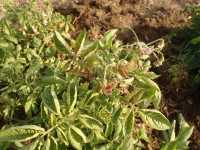Manage Zebra Chip In Potatoes

Zebra chip (ZC), a new disease of potato in the U.S., Mexico, Central America, and New Zealand, has caused millions of dollars in losses to the potato industry. ZC is characterized by a severe dark and light striped symptom pattern in raw and fried chips and fries processed from infected potato tubers, affecting their taste and making them commercially unacceptable.
The disease also causes serious losses to the fresh market, tablestock, and export potato industry. In the U.S., ZC had been confined to the Southwestern part of the country; however, the disease was documented for the first time in Idaho, Oregon, and Washington potato crops in 2011, threatening more than 50% of the U.S. potato production.
ZC has been linked to the new bacterium Candidatus liberibacter solanacearum, transmitted to potato by the potato psyllid. This bacterium also severely affects other crops, including tomato, pepper, and eggplant. Currently, all management tactics for ZC are targeted against the potato psyllid, its insect vector.
The Source Of The Problem
Potato psyllid adults are small, measuring about 0.1 inch long, and resemble tiny cicadas. Adults are active in contrast to the largely sedentary nymphal (immature) stages and readily jump when disturbed. Adult longevity ranges from 20 to 62 days, and females usually live two to three times longer than males. Females lay 300 to 500 eggs over their lifetime. Both nymphs and adults produce large quantities of whitish excrement, which can help identify and locate the insect.
The potato psyllid seems to be adapted for warm but not hot temperatures. Optimum psyllid development occurs at approximately 80°F. Oviposition, hatching, and survival are reduced at 90°F and cease at 95°F. A single generation may be completed in three to five weeks.
The potato psyllid is native to North America and is common in the southwestern U.S. from western Texas to California. The psyllid also has been noted in Mexico and Central America. The insect is found in Washington, Oregon, and Idaho where it usually colonizes potato fields in late June and early July.
The origin of psyllids colonizing potatoes in the Pacific Northwest has not been established but it is suspected that the insects migrate into the region from the southern California area. Also, there is evidence that the potato psyllid is able to overwinter in the Pacific Northwest, especially on bittersweet nightshade, and local populations may contribute to psyllids colonizing potato fields in this region of the U.S.
Symptoms Of Damage
The potato psyllid is one of the most destructive potato pests in the western hemisphere. Historically, damage to potato crops is thought to have been due to its association with “psyllid yellows” disease, presumably caused by a toxin that is transmitted during the insect’s feeding, especially by nymphs. The nature of this toxin has not yet been demonstrated.
Plant symptoms of psyllid yellows include arrested growth, erectness of new foliage, yellowing and purpling of new foliage with basal cupping of leaves, shortened and thickened terminal internodes, axillary branches, and aerial tubers. Below-ground symptoms include setting of excessive numbers of tiny misshaped potato tubers, production of chain tubers, and early breaking of dormancy of tubers.
Crop damage due to potato psyllid has been exacerbated by the association of this insect with Liberibacter, the ZC pathogen. The primary way that psyllids acquire and spread Liberibacter is by feeding on infected plants. Not only do psyllids become infective for life, they also transmit the bacterium to their offspring, which contributes to ZC spread between geographic regions by dispersing psyllids and helps maintain the bacterium in the regions during the insect’s overwintering period.
The potato psyllid generally overwinters as adult. A single adult potato psyllid is capable of inoculating the bacterium to potato within a period as short as six hours, leading to development of ZC. Foliar symptoms of ZC closely resemble those caused by psyllid yellows and purple top disease (caused by leafhopper-transmitted phytoplasmas). Disease symptoms in tubers consist of collapsed stolons, browning of vascular tissue concomitant with necrotic flecking and streaking of internal tissues; symptoms become more pronounced upon frying chips or fries processed from infected tubers.
ZC symptoms generally develop in potato tubers about three weeks following exposure of plants to infective psyllids. Tuber development ceases upon the onset of ZC symptoms, resulting in substantial yield loss or lack of tuber set. In addition, levels of tuber solids decrease as soon as initial disease symptoms are observed, whereas reducing sugar levels in tubers increase dramatically, significantly lowering potato processing quality.
Monitoring And Management
Monitoring the potato psyllid is crucial to effective management. The adult populations are commonly sampled using yellow sticky cards, pan traps, sweep nets or vacuum devices, while egg and nymph sampling requires visual examination of foliage. Typically, psyllid populations are highest initially along field edges, but if not controlled, the insects will eventually spread throughout the crop.
Potato psyllid control is currently dominated by insecticide applications (see control options at www.
nwpotatoresearch.com/IPM-Home.cfm) but even with conventional insecticides, this pest is difficult to manage. Good coverage is important because psyllids are commonly found on the undersides of leaves. Also, the different life stages require the use of specific insecticides, as it has been shown that chemicals that control adults do not necessary control nymphs or eggs.
Therefore, caution is needed when selecting insecticides, to ensure that a product effective against the targeted life stage is used. Psyllids have been shown to develop insecticide resistance, thus alternative strategies should be considered. No potato variety has, so far, been shown to exhibit economically sufficient resistance or tolerance to ZC.









